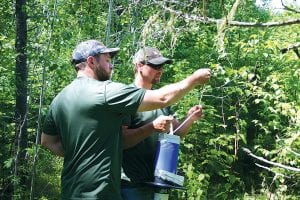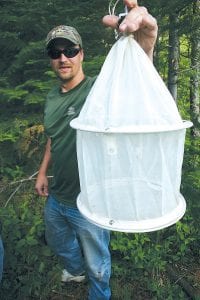Nick Bogyo is shown here helping Nick Kasper to set a mosquito trap in a tree. The next day the two checked their traps and Kasper displayed his catch in this photo above. The two young men will be trapping mosquitoes in Cook County until the frost. The captured mosquitoes are frozen and sent to a lab where scientists will determine what types of species we have in the Northland and then checked to see if these winged little beasts are carrying any diseases or viruses that could hurt moose, humans, or adversely affect any other animals.

Davey Crockett, Daniel Boone, Jim Bridger and just about any Native American born before 1950 were great trappers. Some of them legendary trappers. Tyler Kasper and Nick Bogyo may join that group.
Then again, maybe not.
The 1854 Treaty Authority of Fond du Lac and Grand Portage employs Bogyo and Kaspar and one of their jobs is mosquito trapping in Cook County.
Instead of leg traps or teensy weensy snares or using spring-loaded blocks of wood they live trap mosquitoes, or “skeets” as they call them. Once they’ve captured some skeets they freeze them and ship them to the University of Minnesota where they are examined to see if they are carrying any viruses or diseases. Scientists are also trying to identify just what types of mosquitoes are buzzing around the Northland and so far that has proved to be daunting.
“They [researchers] have started speciating the mosquitoes in the lab and apparently they are finding it difficult to speciate Aedes, which makes the process more challenging,” said Erika Butler, D.V.M., wildlife veterinarian of the Minnesota Department of Natural Resources (DNR).
Aedes is a genus of mosquito found on all continents, and some species of this genus can transmit the spread of serious diseases.
Butler said the process in the lab involves “pooling them [mosquitoes] according to species, trap location, and trapping date. But we likely won’t be submitting the skeets for virus isolation until the trapping season has come to an end, so it will be a bit before we have those results.”
When working both Bogyo and Kasper wear caps, but not coonskin caps, which was a little disappointing. Instead, they wore green camouflage caps and shirts and blended into the forest very well. All the better to sneak up on the skeets when setting traps.
They move quietly through the woods on cat-quick feet. Well, sort of quietly through the woods. They move fast but talk, which doesn’t appear to scare off the throngs of mosquitoes in the area.
Good thing, because their work is important. Skeeter trapping can have big implications for the northland and beyond. Not commercial, of course. Bogyo figures one would have to catch about 10,000 skeets to make a small skeeter coat.
“A very small skeeter coat,” he said with a smile.
All kidding aside, both are tremendously nice young fellows who take their work seriously. They are running a trap line on Pine Mountain Road and another near Iron Lake under the direction of Andrew Edwards, a wildlife biologist who is one of the state’s leaders in pursuing what is causing moose to disappear from Minnesota’s landscape.
When I met Bogyo and Kasper on Pine Mountain Road at their secret skeeter trapping spot they were all business as they got their traps ready to hang in the trees: one at chest height and one higher up in the canopy. They worked quickly, occasionally brushing away mosquitoes that tried to slow them from their task. The traps look like lanterns, and each included a light and some CO2 that helps attract mosquitoes.
Asked if they ever thought they would be trapping mosquitoes for a living, Bogyo smiled and said no. He’s been working for a year, while Kasper has one month of employment with the 1854 Treaty Authority.
Joking aside, Edwards and crew are on a very important mission. They are getting samples of mosquitoes from several locations in Cook County (and throughout the Northland) that will be examined for the eastern equine encephalitis (EEE) virus, or, as Butler refers to these nasty bugs, “West Nile virus’s evil sister.”
“The reason we are doing this is because we did some hunter harvested moose disease surveillance and came up with some moose that tested positive to EEE,” said Butler.
“Until we had these results we didn’t even know that we had EEE in that portion of the state. Additionally, we aren’t sure what sort of impact this disease could be having on our moose population, and we’d like to know more about its distribution on the landscape.”
Butler is referring to the crash in the moose population throughout Minnesota. In the Northwestern part of the state there are fewer than 20 moose left from a population of 4,000 in the 1990s. In Northeastern Minnesota the population has dropped from roughly 8,840 moose in 2006 to 4,230 moose in 2012.
Just why moose have been dying in record numbers has scientists and Northlanders worried. For the past decade wildlife biologists have been looking at a large variety of factors—everything from global warming to deer ticks to predation from bears and wolves to food sources (or lack thereof) and on and on— that might be contributing to the demise of one of the northland’s most majestic mammals.
And now mosquitoes are the latest item of intrigue, and maybe one more piece to help fill this jagged, jumbled puzzle.
Trapping began mid-June and will last until the frost. Trappers are a mix of DNR employees, Fond du Lac employees, and volunteers. A student has been funded through a University of Minnesota summer scholar’s grant to do the skeeter speciation. The student will work with a veterinary entomologist at the University of Minnesota.
At each location two traps are set, one chest height and one hung up in the canopy. According to Butler, “The traps are essentially coolers with dry ice and a fanhookeduptoa6voltbattery which runs the fan and a light.”
Mosquitoes are attracted to the traps by the light and the CO2, which is directed by a fan. The mosquitoes are blown into a net that hangs off the bottom of the trap. “When we check the trap, we will simply remove the net and put them on ice to kill them and then store them in a freezer until they can be processed,” Butler said.
Because of the project’s importance the DNR has teamed up with the University of Minnesota College of Veterinary Medicine, the University of Minnesota Department of Entomology, the Minnesota Department of Health, the Metropolitan Mosquito Control District and the 1854 Fond du Lac Natural Resources Council.
The areas picked for trapping include locations where there is a high rate of moose dying a “hot” site and locations where researchers didn’t find any evidence of exposure to the virus, a “cold” site.
The Pine Mountain site is considered to be a “hot” site while the Iron Lake site is a “cold” site.
“We are looking to see if there is a difference in the mosquito species present in these areas. Additionally, we will test the skeets that are in known vectors for evidence of the virus to see if we can identify it in the mosquitoes themselves. This will be like finding a needle in a haystack,” said Butler.
Researchers are also excited about cataloging which species of mosquitoes are trapped because, as Butler said, “it has been decades since someone has done something like this.”
Paying the tab for this study is a collection of agencies, said Butler. “The Minnesota DNR Wildlife Health Program is covering reimbursement costs for the volunteers and fleet costs for DNR employees and the DNR is paying time for any DNR employee trapping. The University Department of Entomology and the College of Veterinary Medicine, the Minnesota Department of Health and the Metro Mosquito Control District are all assisting with trap allocations.
“This is truly a collaborative project that has implications for both wildlife and human health,” said Butler.
For Bogyo and Kasper the trap line has been a chance to help figure out why moose are disappearing and maybe to help stop or slow the spread of illness to humans. Important work to be sure, but as they set and check their traps they fight off mosquitoes with a smile. They take their job seriously, one bite at a time.



Loading Comments